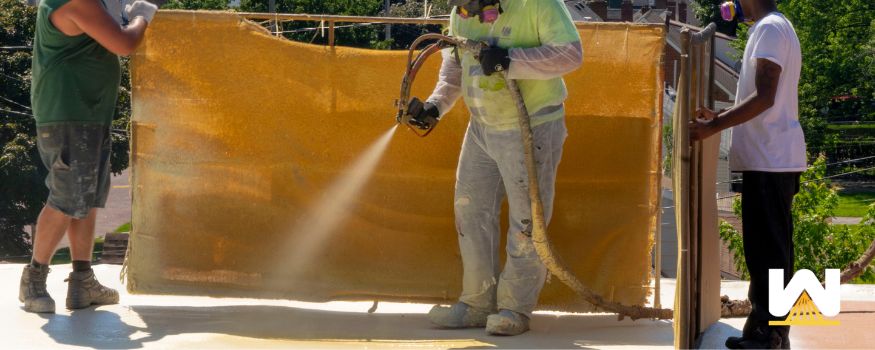You may have heard the term “Spray-on roofing system,” “Spray foam roofing,” “SPF,” “spray polyurethane foam,” etc.
They all are the same thing 😊
The term you use doesn’t matter.
What matters is if you own or manage a commercial building and you need to handle roofing issues, you know all the options you have.
Not knowing at least a little bit about spray foam would be the same as searching for a car with great gas mileage, and you didn’t know electric vehicles existed.
Spray foam is entirely different than traditional roofing systems, such as
- It’s fluid-applied (it’s not a rolled-out sheet).
- The slope can easily be customized
- It’s renewable
And because of its application, there are other advantages that we’ll get into later.
In this article, you’ll learn:
- What’s the ballpark cost for a spray-on roofing system per square foot (and all the factors that make it go up or down)
- What problems does the system have?
- What advantages does spray foam have over other commercial roofing systems?
- How is it installed?
- Is the spray foam used for roofing the same as the foam used for residential?
- What’s the main reason why property owners choose the spray-on system?
- Is there required maintenance on a foam roof after it’s installed?
Buckle your seatbelt; let’s get started!
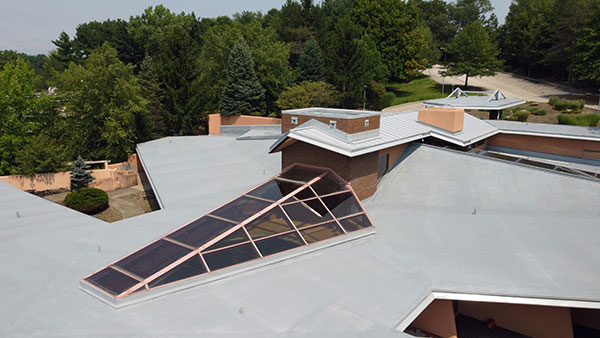
What is the ballpark cost for a spray-on roofing system per square foot (and all the factors that make it go up or down)
As of February 2025, a spray foam roof costs roughly $5 – $10 per square foot. There are many (MANY!!!!) factors that influence the cost, such as:
The price of the material
Prices have fluctuated so much in the past couple of years that it’s sometimes difficult to even come up with a price range. The spray-on roofing system has four main “ingredients.” The A and B sides of foam, coating, and granules. Factors such as the economy, labor shortages, raw material shortages, and supply chain issues all contribute to the cost of a project.
The square footage of your roof
This has to do with economies of scale. A 100,000 sq. ft. project may cost $5 per square foot, but a 1,000 sq. ft. roof with the same details may cost $8 per square foot.
It takes time to get to a roof, set up safety, move equipment, etc. These are eliminated (or become a tiny part of a project’s cost) on a larger roof.
The desired R-value and warranty length
In short, more material is going to cost more.
Spray foam has an R-value of 6.5 per inch of thickness. Need an R-20? Roughly 3 inches of foam will get you there.
Don’t care about R-value? The minimum thickness spray foam needs to be at to perform correctly is 1 inch.
Installing 3 inches vs. 1 inch over a 20,000 sq. ft. roof will be a substantial price difference.
Spray foam will degrade when exposed to UV rays. Therefore, a protective coating is always installed over the foam within 72 hours.
The thickness of the coating is what determines the warranty length.
- For a 10-year warranty, a 20-mil thickness of coating needs to be installed.
- For a 15-year warranty, a 25-mil thickness of coating needs to be installed.
- For a 20-year warranty, a 30-mil thickness of coating needs to be installed.
A longer warranty warrants more materials, which costs more.
Amount of wet insulation
No roofing system (not spray foam, TPO, metal, etc.) should be installed over wet insulation. Wet insulation is identified with a visual inspection and/or an infrared survey.
These areas are removed, transported to a landfill, and similar materials are installed before a spray foam system can go down. Lots of labor hours go into the removal of the areas, but also the time to put new material down.
Landfill costs (and the transportation to get there) also contribute to the project’s cost.
A roof with 2% wet insulation versus the same one with 20% wet insulation…there’s going to be a lot more labor costs with the wetter roof.
Here are some other things associated with cost:
- How far away is your building from the contractor
- How easy/difficult it is to setup
- If there’s a great risk of overspray (more on this later)
- If skylights need removed/replaced
There are probably a hundred more things that affect cost. Every project is different, but I hope this gives you a clearer image of the variables influencing price.
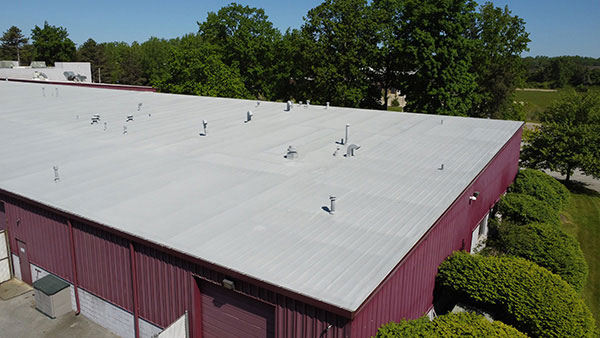
What problems does a spray foam roof have?
There are three main problems with spray-on roofing systems.
- Overspray
- Bad Contractors
- Can’t spray when under 50 degrees or windy
Overspray
Spray foam is fluid-applied. It’s like a mist. The wind can easily carry it away. If the foam isn’t controlled, foam can land on nearby vehicles and windows.
This is called “Overspray potential”.
Is your building in the middle of nowhere? Awesome!
Is your business a car dealership? Not so much 😊
Overspray can be eliminated by moving or covering cars, using windscreens or spray booths, or not spraying if it’s too windy.
Bad Contractors
A lot of chemistry goes into installing a successful spray foam roofing system. Spray foam is heated, pressurized, and mixed before it lands on the roof.
The product can be installed too A-side or B-side heavy.
It can be installed too thin or too thick.
The sloping can be off.
The speed at which the foam cures can be too slow or too fast.
Some contractors buy into the positives of spray foam but have little to no experience installing it. When you have no experience, you most likely install an inferior product.
Be very careful who you choose when you go with a spray-on roofing system.
Can’t spray when under 50 degrees
There are some weather restrictions when installing foam. It must be 50 degrees and rising for spray foam to be installed correctly.
This limits the install period for regions where it gets below 50 degrees. In Ohio, the usual install season is from April until October.
Some building owners scramble in September/October to install a new roof before winter. Sometimes the install can’t happen because of a backlog and/or declining temperatures.
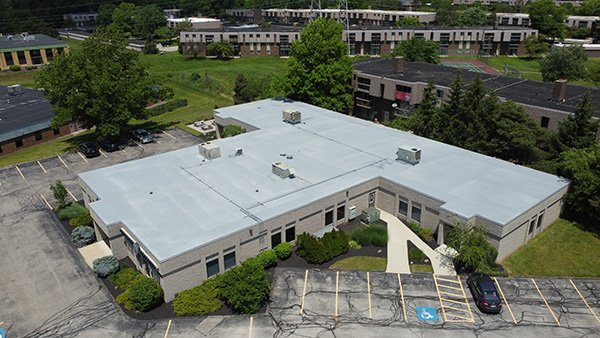
What advantages does spray foam have over other commercial roofing systems?
The spray-on roofing system has many advantages over TPO, Metal, and other traditional roofing systems, such as:
No seams
Seams are under the most stress on a commercial roof. When these loose adhesion, water has a clear path to the roofing areas (usually insulation) below.
A spray foam roof is seamless. The entire roof is 1 continuous layer. There’s no piecing sheets together. When there are no seams, there’s one less way that a roof can leak that’s eliminated.
No fasteners
Fasteners can back out, become damaged, or be installed incorrectly. When this happens, water has direct access below.
Spray foam is self-adhering. It doesn’t need anything to hold it in place.
Can easily customize slope
Many roofs have ponding/standing water because of improper slope. Because spray foam is fluid-applied, raising an area to create proper sloping is very easy. Just spray more product in the area.
Traditional roofing systems (since they are flat) need to create a slope with insulation boards below. This is very labor-intensive and expensive to accomplish.
Can easily be installed around penetrations
A penetration is anything that comes through the roof. Examples of penetrations include:
- Skylights
- Pipes
- Drains
- Curbs
- HVAC units
Since spray foam is fluid-applied, it goes right around a penetration and keeps on going. There is no interruption to the install.
Since traditional roofing systems are essentially sheets, they need to be custom-cut to fit around penetrations. Some roofs have hundreds of penetrations. A penetration slows the installation of a non-fluid applied roofing system.
Others
- Spray foam has the highest R-value of any roofing insulation. It has an R-value of 6.5 per inch of thickness. Other insulations can reach the same R-value, but a thicker product must be installed.
- The Spray-on roofing system is renewable. When the warranty period is over, the roof can be recoated to extend the warranty. This avoids the costly tear-off that many traditional roofing systems succumb to.
- Spray foam is closed-cell. This means water cannot travel through it. If the foam roof is punctured, water sits in the puncture and does not move. Other roofing systems that have open-cell insulation, water saturates it. When there’s enough saturation, the water travels down to the deck and into your building.
How is a spray-on roofing system installed?
After the roof is prepared correctly, the spray foam product is pumped from two separate 55-gallon drums that sit in a box truck near your building.
The product is pumped, heated, and pressurized through hoses. The hoses attach to a mixing gun, where the mist-like product goes on the roof.
The foam cures and rises 30x its size within seconds.
Once the foam is completely cured, the base coat of coating is installed. Once the base coat has cured, the top coat of coating is installed.
In some cases, granules are embedded into the topcoat of coating.
Here’s a video of spray foam being installed from start to finish:
Is the spray foam used for roofing the same as the foam used for residential?
No.
For roofing purposes, closed-cell 3lb spray foam is used. This is denser than open-cell 2lb or 1/2lb foam used for residential insulation.
Foam used indoors isn’t exposed to the same elements that the foam on a roof is exposed to.
What’s the main reason why property owners choose the spray foam system?
It’s really a combination of:
- Application/Cost
- Trust
Application/Cost
Some roofs have no option but to go with a spray-on roofing system or do a complete tear-off. Some school systems don’t have the budget for a complete tear-off. But with spray foam’s ability to go over the existing roof, the project’s cost is within budget.
Some buildings have large metal roofs that are leaking. They can’t afford to rip all those off and install a new metal roof. In most cases, spray foam can go over an existing metal roof, which makes the project more affordable.
Trust
Truthfully, every roofing system (not just spray foam) will work if installed correctly.
When a roofing contractor has longevity and a list of successful roofing projects from decades ago that are still watertight today, that instills trust that they will do a great job.
Combining the cost-effectiveness of the application with the trust of a reliable contractor, it gives the client confidence that the job will be completed correctly and efficiently.
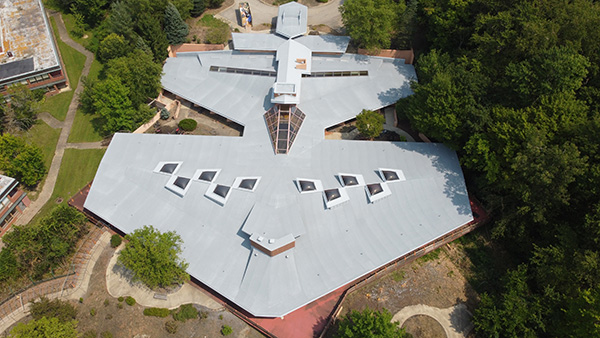
Is there required maintenance for a spray-on roof after it’s installed?
Yes and no.
If you get a spray-on roof and a 10-20-year warranty, you don’t need a signed maintenance agreement with the roofing contractor to maintain the warranty.
But, if you want to do maintenance yourself, such as:
- Cleaning out drains regularly
- Caulking areas of coating that have become damaged
- Cleaning out gutters
That’s totally fine.
But if the coating or foam is damaged because of negligence to maintenance, the warranty can be voided.
The roof is out-of-sight, out-of-mind, and is easily forgotten about. It’s beneficial to consider getting a routine maintenance agreement with a contractor because:
- The roof won’t be forgotten about
- The repairs (if any) will be correctly identified
- They will have the proper tools and materials
- They can document repairs and areas to look out for next time
- The warranty will be active throughout the initial agreement
What’s next?
Now that you know 90% about the spray-on roofing system, let’s look at a few case studies where you can learn the entire scope of work for a few projects:
- Sharpsville Container (Spray foam over steep slope metal) – Learn how spray foam was installed over 4 different roofing systems, including steep slope metal, saving the client hundreds of thousands of dollars.
- Heskett Middle School (Spray foam over Gravel BUR) – Learn how spray foam was installed 50% faster and for $1M less than a complete tear-off.
- Oakview Elementary (Spray foam over EPDM) – Learn how a 20-year-old EPDM roof was “re-roofed” with spray polyurethane foam.

